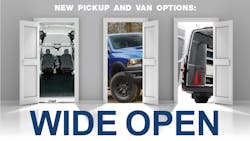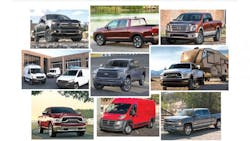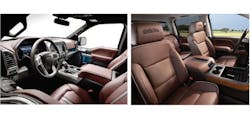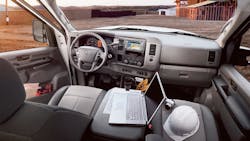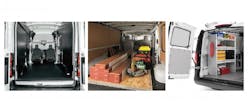Even as automakers collectively have been seeing sales slumps in the U.S. market in passenger cars, and sedans in particular, it’s been a banner year so far for the pickup truck. Partly driven by several years of lower fuel prices, the American appetite for this versatile hauler is healthy and growing, and manufacturers are also seeing rekindled interest in vans—though that’s on the larger side of the bunch—and their broad potential to serve the business or fleet customer.
So both pickups and vans typically spanning Classes 1-3 are getting another shot in the arm this year as OEMs invest more in their platforms and expand them with new, more advanced and modern options than these vehicles traditionally got, and that includes comfort, convenience and safety. Individual buyers and small businesses often consider these trucks as personal vehicles or for “weekend warrior” missions, and the pickup-van uptick is a boon for fleets, since now they’ve got more—and often more affordable—choices when it comes to vehicles necessary to get the job done.
Yet some businesses still need to have their eyes opened to the newer possibilities and capabilities of these vehicles, argued Dave Sowers, head of Ram Commercial Trucks. “I’ll be honest with you. Sometimes it’s tough to get guys to consider changing their configurations. They see changing their formula for vans, for example, as a risk for them,” he told Fleet Owner. “The way businesses and fleets look at their vehicles, to some extent, is a necessary evil. Or to put it a different way, if I don’t notice it—if I don’t have to do anything with it or change it—all the better. They’d rather focus on their main mission.”
Now may be the time to start noticing. Today’s pickup trucks and vans can help get that fleet or business mission done better than ever before in several ways. And these vehicles could even offer tangential benefits such as in hiring the best talent. That’s one focus manufacturers have had in designing their vehicles and expanding the list of available options: if once upon a time they were, vans and pickups are by no means a “one size fits all” segment anymore.
Look for more global platforms for these vehicles as their makers bring more models sold abroad to the United States rather than designing exclusively for this market. “That will be the way of the future, particularly with the high cost of homologation in the U.S.,” noted Mark Namuth, senior manager of fleet and commercial sales for Nissan’s light commercial vehicle business unit.
Worth a mention in that vein, be prepared to look in some unfamiliar places: Manufacturers that you might not have expected are getting in on this gold rush. A good example of that is Mercedes-Benz, which in July unveiled its production X-Class pickup truck intended for European and global markets outside the United States. Should such a seemingly atypical vehicle for the OEM take off, one day it could venture to or influence trucks sold on these shores.
A large chunk of new 2018 model pickup and van options centers on technological upgrades, and they’re coming in a number of ways. In terms of media, navigation and connectivity, look for available larger, higher-resolution touchscreens that can do more and pipe more data through WiFi hot spots.
Ford announced an optional 4G LTE embedded hot spot for the facelifted 2018 F-150 that handles up to 10 connected devices, for example. Across the 2018 Chevrolet Silverado 1500-3500HD/GMC Sierra 1500-3500HD lineup, General Motors made 7-in. touchscreen radios standard on base models and an 8-in. touchscreen on others, with navigation standard or available with the latter. Honda also has an 8-in. touchscreen with navigation available on the mid-size 2018 Ridgeline pickup, which was all-new for 2017, and Ram Trucks added new optional 8.4-in. radios with 4G LTE connectivity across the 1500-3500 pickups for 2018.
Telematics and fleet management systems capability is increasing for the new model year as well: Buyers can get their Ram 1500-3500 pickups with a fleet telematics module for 2018. And many, if not most, of the latest vans and pickups, offer “plug and play” type connectivity for telematics, such as Ford and Nissan’s vehicles that offer an easy install for fleet GPS and management systems from Telogis, a Verizon Company.
The U.S. Dept. of Transportation has mandated rearview cameras in all vehicles under 10,000 lbs. by mid-2018, so that has also come into play. Expect standard—or at least still available for now—cameras for that purpose on most 2018 pickups and vans. Notably, though, some OEMs are upping the ante with better and/or more camera views for the new model year. Ford Transit mid- and high-roof vans will have a high-mounted rearview camera, and the F-150 pickup now has an available 360-degree camera to assist with parking and hooking up a trailer.
Although Nissan hasn’t officially released 2018 model info for its Titan and Titan XD full-size pickups, the automaker has its “Around View” technology available now for certain trim levels and standard on premium models. The system uses four cameras to provide a composite overhead view of the surroundings to the driver. The NV 1500-3500 passenger and cargo vans, meanwhile, have available or standard rearview cameras.
Perhaps the most significant new tech options in the pickup and van segment are advanced and active safety features, in which manufacturers say fleets and business buyers are showing keener interest. Though the visual and performance indulgences and custom options offered in pickups and vans don’t typically suit those buyers, there’s certainly a bottom-line and public safety benefit with the latest advanced safety technologies in their ability to mitigate or avoid collisions. And they’re proving an easier sell.
It’s an area where the light commercial vehicle segment, like passenger cars more broadly, is outpacing heavier vehicles. And it’s pickup trucks in particular to date: Toyota, for one, has added its multi-feature advanced safety suite as standard on the 2018 Tundra full-size pickup. That includes a pre-collision system with pedestrian detection, lane-departure alert, automatic high beams, and radar-based active cruise control.
A similarly adaptive, “smart” cruise control that uses both camera and radar and a pre-collision system with pedestrian detection also is newly available on the Ford F-150. Those features are added to the option list along with previous ones, including a lane-keeping system and blind spot assistance system that uses taillight-mounted radar in order to “see” far enough to accommodate a 33-ft. trailer.
Although all OEMs have different official product names for them, many now offer or have as standard a number of similar advanced safety technologies. Honda’s Ridgeline pickup offers active braking and forward collision warning, lane departure warning, and adaptive cruise as options. GM already includes its docket of advanced safety equipment—which features a driver-alerting seat—on premium model Chevy Silverado/GMC Sierra pickups and as standard or available options on mid-level trims.
The same technologies are migrating to vans in the commercial segment, but more slowly. Mercedes-Benz’s Sprinter 2500-3500 cargo and passenger vans, though little changed for 2018, feature a load-adaptive electronic stability program (ESP) and crosswind assist as standard, with optional automatic high beams and lane-departure warning. The OEM’s compact Metris has a load-adaptive ESP, crosswind assist, and driver drowsiness warning as standard and lane-departure warning as optional.
PERFORMANCE & APPEARANCE
New engine options so far announced for the pickup and van segment have been limited, but there’s plenty of available capability already in this group. Still, watch for the 2018 Ford F-150’s adjustments in this regard: For the first time, the truck gets an optional 3.0L turbo diesel that should start arriving at dealerships early next year, according to Tim Stoehr, general fleet marketing manager at Ford. “We expect it to produce best-in-class mileage in our lineup,” he told Fleet Owner. “It further expands on the choice that we’re bringing to market.”
Other engine adjustments for the half-ton pickup are on the way as well, with a new standard, slightly smaller 3.3L V6 that bumps the previous 3.5L V6 but offers the same 282 hp./253 lbs.-ft. of torque. A second-generation 2.7L EcoBoost V6 engine gets another 25 lbs.-ft. of torque for 400 lbs.-ft. max output at just 2,750 rpm; like the 3.5L EcoBoost, it will be paired with a new 10-speed automatic transmission. “With 10 gears versus six, the engine is operating in the most efficient rpm range more often,” Stoehr noted.
Ram’s 2018 3500 Heavy Duty pickup went into production in mid-August, and its optional Cummins I-6 6.7L turbodiesel engine gets more boost and massaged fuel flow for another 30 lbs.-ft. of torque, upping the truck’s maximum to 930 lbs.-ft. With a newly engineered fifth wheel hitch design, the 2018 Ram 3500 boasts towing capacity of 30,000 lbs.
Toyota’s full-size Tundra arrives with a new TRD Sport variant for 2018, complementing its recently introduced little brother, the Tacoma TRD Pro. The beefed-up Tundra TRD Sport is available as a crew cab or double cab and is powered by a 5.7L V8 making 381 hp. The truck also boasts heavier-duty handling componentry with sport-tuned shocks and front and rear anti-sway bars.
Hoping to reach more customers who are looking to stand out, Ram has also expanded options this year across its 1500-3500 pickups to that end. The “Big Three” U.S. automakers all have noted more uptake in their higher-end pickup trim packages, and Ram has added to its offerings with a new Limited Tungsten Edition that the OEM described as “ultra-luxurious.”
It’s another sign of the changing expectations and new possibilities for the segment, folding in top-shelf treatments such as genuine wood trim, premium leather interior, suede headliner, heated steering wheel, power-adjustable pedals with memory, heated rear seats, and front seats that get both heating and ventilation. The Tungsten Edition will be available in Crew Cab and Mega Cab configurations for the Ram 1500-3500 lineup in two- or four-wheel-drive and on short- or long-wheelbase models.
READY, SET, UPFIT
No look at today’s pickup and van options would be complete without a mention of upfit potential. Not only have OEMs broadened their own available configurations of these vehicles, they’re working more in tandem with upfitters to allow additional customizability of pickups and vans. The idea is to tailor these vehicles more finely based on businesses’ vocational needs.
Pass-through partnerships like Mercedes-Benz’s Master Solutions program let the business customer arrange for certain upfitters to install shelving or other body enhancements on Sprinter and Metris vans, for example, and the buyer can take delivery directly rather than having to go through multiple steps. In another example, upfitter Spartan Motors, owner of the Utilimaster brand, just opened a nearly 150,000-sq.-ft. facility right next to Ford’s Kansas City Assembly Plant where the Transit van is made. Spartan said it will allow faster, easier add-ons to those and other vehicles that can then be delivered straight to the customer from dealerships.
That’s a trend to watch going forward, contended Nissan’s Namuth, and the palette of available upfits themselves are becoming much more diverse. “You’re seeing a lot more driver comfort add-ons; you’re seeing a lot of racks and bins and arrangement systems that are tailor-made for the individual, not the fleet,” he noted.
“A fleet may have an assortment of drivers, and a cargo management solution that works for one driver may not be the same for another,” Namuth observed.
CONFIGURATIONS AND CONVENIENCE
The pickup and van segment offers a plethora of ways to serve up these vehicles. This is about expanding options to fit whatever requirement: Businesses and their needs vary enormously, and automakers all want to offer them the best canvas on which to paint.
And it’s an area where the vans in particular shine. Namuth said that in addition to low fuel prices that have helped drive commercial buyers from compact to larger vans, the OEM is seeing some transition away from pickups with service bodies to large vans as well. Vans in the one-half to one-ton grouping remained somewhat stagnant traditionally in the U.S., he explained, while pickup trucks received all the engineering and technological upgrades.
“But what we’ve seen in recent years is an infusion of investment in the large van segment,” Namuth told Fleet Owner. That has brought more choice in the form of the OEM’s NV 1500-3500 vans, the Mercedes-Benz Sprinter, the recent additions of Ford’s Transit and Ram’s ProMaster vans transplanted from the European market, and the Chevrolet Express/ GMC Sonoma vans.
“Customers are now shifting into larger vans,” Namuth said, “because they’re getting better fuel economy, more utility, and a vehicle where they can lock their products and tools inside versus being outside in a box or service body.”
Beyond a shift toward larger vans—which has also left the compact van segment flat or at a loss this year—there’s a desire for taller ones. “With the launch of the Transit in medium- and high-roof variants in North America that we previously didn’t offer, the trend is to go to higher-roof models,” Ford’s Stoehr said. “And once they [drivers] can stand, they usually never want to go back,” he added, unless vans need to drive in height-restricted areas.
Ram touts the same advantage with its front-wheel-drive ProMaster, an exclusive for the large van segment, and compact ProMaster City vans. With the engine and transmission underhood and driving the front wheels, it allows for a lower floor at the rear, Ram’s Sowers pointed out. “For any given roof height on the outside, that gives us more interior height—more cubic feet to store things or space to stand up,” he said. “It makes for a lower step-in height, and in some cases, we’ve got operators making 60 cycles in and out of a van in the course of a day, and it makes a big difference.”
Front-wheel-drive also makes the ProMaster more maneuverable and gives it better traction, Sowers added. He contended that the configuration’s more carlike drivability and handling can help businesses focus on hiring the people who are best at their trade without as much emphasis on them being able to drive larger, heavier vehicles.
A number of convenience options in vans and pickups also stand out as customer-driven innovations. This year, Ford added a heavy-duty cargo floor option for the Transit along with manual step-down parking brake, which customers like the RV community and builders wanted to allow more room between the front seats or for a swiveling front seat. 2018 Ram 1500-3500 pickups offer a remote exterior switch to activate LED truck bed lights, while Nissan has a “trailer light check” function for the Titan and Titan XD that cycles through turn signal, brake and running lights designed to make towing a one-person proposition.
About the Author
Aaron Marsh
Aaron Marsh is a former senior editor of FleetOwner, who wrote for the publication from 2015 to 2019.
